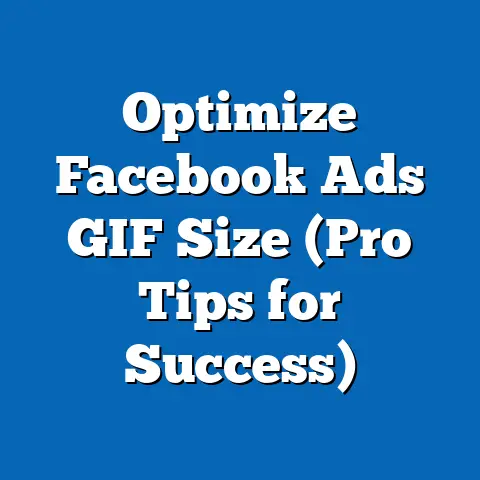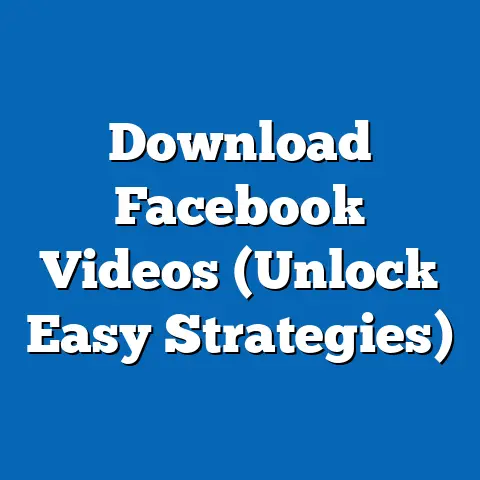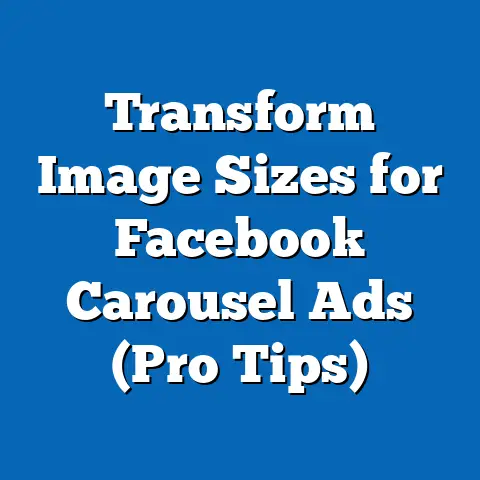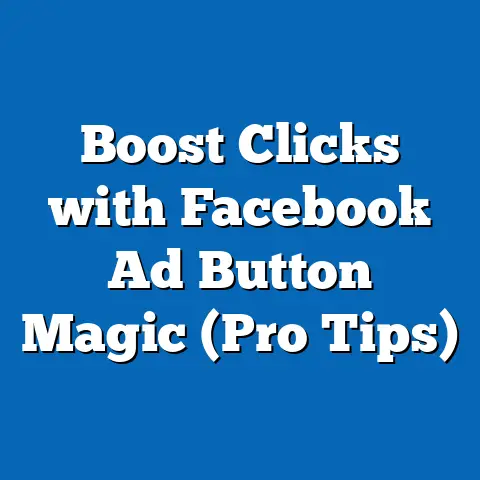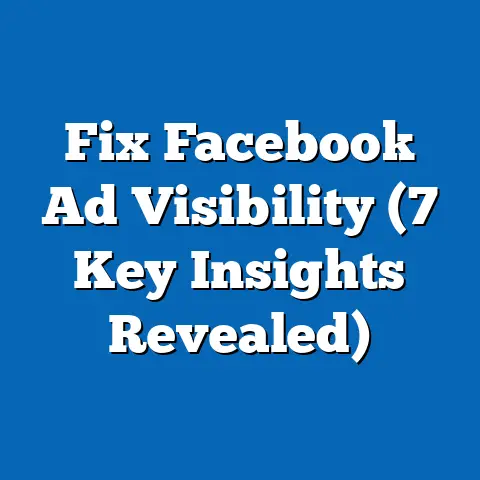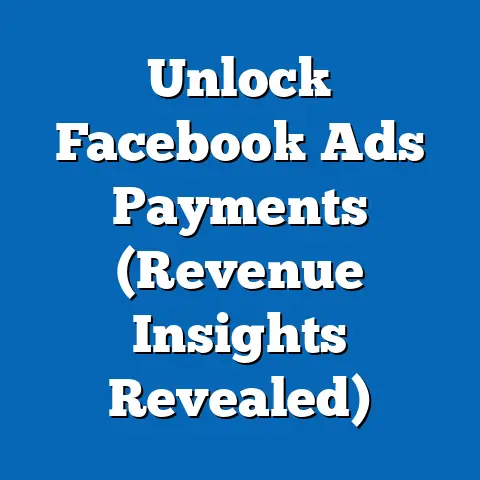Unlock Facebook Page Ads Transparency (Essential Insights)
In an era reminiscent of Orwell’s 1984, where information is both omnipresent and obscured, the digital realm has become a battleground for political influence, with Facebook serving as a central arena. The platform’s vast user base—2.9 billion monthly active users as of 2022, according to Meta’s own reports—makes it a powerful tool for shaping public opinion through targeted political advertisements. Yet, the opacity of these ads, often cloaked behind algorithms and undisclosed funding, has raised critical questions about transparency, accountability, and the demographic groups most affected by or engaged with these campaigns.
Background: The Push for Transparency in Digital Advertising
The catalyst for Facebook’s transparency tools emerged from the fallout of the 2016 U.S. presidential election, where foreign interference and misinformation campaigns, notably by Russian operatives, exploited the platform’s ad system to influence voters. A 2019 report by the U.S. Senate Intelligence Committee found that over 120 Russian-linked pages reached 126 million Americans through ads and organic content. This scandal, coupled with the Cambridge Analytica data breach, exposed how personal data was weaponized to micro-target voters, prompting global demands for greater oversight of digital political ads.
In response, Meta launched the Ad Library, a searchable database allowing users to view active and historical ads on political and social issues, including details on funding, targeting criteria, and reach. While this tool offers unprecedented insight, it is not without limitations—data on micro-targeting demographics is often generalized, and enforcement of ad labeling remains inconsistent. Understanding who engages with these ads, and why, is essential to grasping their impact on political discourse.
Demographic Composition of Facebook Political Ad Audiences
The demographic makeup of audiences engaging with political ads on Facebook is diverse yet reveals distinct patterns shaped by age, education, race, and geographic location. According to a 2021 study by the Pew Research Center, 70% of U.S. adults use Facebook, but political ad engagement is disproportionately high among users aged 50 and older, who account for 45% of ad impressions despite comprising only 32% of the user base. This skew is likely due to older users spending more time on the platform and exhibiting higher political interest, as evidenced by Gallup polls showing 78% of adults over 50 report following political news closely.
Education and income also play significant roles. Data from Meta’s Ad Library reports (2020-2022) indicate that political ads often target users with college degrees, who make up 38% of impressions despite being 31% of the U.S. population (U.S. Census Bureau, 2021). This targeting may reflect advertisers’ focus on opinion leaders or swing voters, who are often more educated. Conversely, rural users, who are 19% of the population but receive 25% of political ad impressions, are overrepresented due to their perceived persuadability in key battleground states.
Racial and ethnic demographics show varied engagement. African American and Hispanic users, who represent 13% and 18% of the U.S. population respectively (Census Bureau, 2021), are often targeted in specific campaigns addressing racial justice or immigration, with Meta data showing spikes in ad impressions during events like the 2020 Black Lives Matter protests. However, overall engagement metrics suggest lower interaction rates among these groups compared to white users, potentially due to digital literacy gaps or platform mistrust, as a 2022 Pew survey found 54% of Black users distrust social media as a news source.
Core Beliefs and Values Reflected in Ad Engagement
The core beliefs and values of audiences engaging with political ads on Facebook are inferred from the types of content they interact with, as well as self-reported data from surveys. A 2020 analysis by New York University’s Center for Social Media and Politics found that ads promoting conservative values—such as limited government, traditional family structures, and national security—garnered higher engagement (likes, shares, comments) among users in rural and Southern states, aligning with broader Republican-leaning demographics. Conversely, ads focusing on progressive issues like climate change, healthcare reform, and social equity saw stronger resonance in urban, coastal areas, correlating with Democratic voter bases.
Polarization is a defining characteristic of these interactions. A 2021 study by the American National Election Studies (ANES) revealed that 82% of Facebook users who engage with political ads report only interacting with content that aligns with their pre-existing views, a phenomenon driven by algorithmic echo chambers. This suggests that while ads may reinforce beliefs—such as distrust in institutions among conservative audiences or support for systemic change among progressive ones—they rarely shift opinions.
Religious affiliation also intersects with ad engagement. Evangelical Christians, who comprise 25% of the U.S. population (Pew, 2020), are frequently targeted by ads on issues like abortion and religious freedom, with Meta data showing high click-through rates (3-5%) on such content. In contrast, secular or non-religious users, a growing demographic at 26% of Americans, engage more with ads on science-based policy or separation of church and state, highlighting a values-based divide.
Voting Patterns and Political Engagement
Voting patterns among Facebook political ad audiences reflect broader national trends but with notable nuances tied to digital influence. According to a 2020 report by the Knight Foundation, 59% of frequent Facebook users who saw political ads reported that the content influenced their vote choice to some extent, with the effect most pronounced among undecided or independent voters (65% of whom reported influence). This aligns with electoral data showing that swing states like Pennsylvania and Wisconsin, where ad spending was highest in 2020 (over $50 million per Meta’s Ad Library), saw tight margins of victory, often under 1%.
Engagement levels also correlate with turnout. A 2022 study by the University of Southern California found that users exposed to “get-out-the-vote” ads on Facebook were 2.3% more likely to vote compared to a control group, with the effect strongest among younger users (18-29), who historically have lower turnout rates (44% in 2020 per U.S. Census). However, this digital mobilization is uneven—older users, already more likely to vote (71% turnout in 2020), engage more with issue-based ads than turnout campaigns, suggesting ads reinforce rather than expand participation among certain groups.
Partisan differences in engagement are stark. Meta’s 2020 election data shows Republican-leaning ads had a higher average reach per dollar spent ($0.12 per impression) compared to Democratic-leaning ads ($0.09), potentially due to more effective micro-targeting of emotionally charged issues like immigration or gun rights. Yet, Democratic ads saw higher engagement in urban centers, correlating with their stronger performance in densely populated counties (Biden won 71% of counties with over 500,000 residents in 2020, per AP vote data).
Policy Positions on Major Issues
The policy positions reflected in Facebook political ads and their audience responses reveal both consensus and deep divisions. On economic issues, ads promoting tax cuts or deregulation often target higher-income users (over $75,000 annually), who represent 30% of ad impressions despite being 25% of the population (Census Bureau, 2021), and garner positive engagement in conservative-leaning states. In contrast, ads advocating for wealth taxes or student debt relief see higher interaction among users under 35, with a 2021 Pew survey showing 62% of this age group supporting such policies.
Social issues like abortion and gun control are lightning rods for engagement. Meta’s Ad Library data from 2022 shows ads opposing abortion rights received over 10 million impressions in the wake of the Dobbs v. Jackson decision, with 70% of interactions from users in Southern and Midwestern states. Gun control ads, conversely, saw peak engagement in urban areas post-mass shootings, with a 2022 Gallup poll indicating 58% of urban Facebook users favor stricter laws compared to 31% of rural users.
On climate change, a growing issue in political advertising, ads supporting green energy initiatives resonate with younger, college-educated audiences, with 68% of 18-29-year-olds expressing concern over climate in a 2022 Pew survey. However, ads denying climate science or opposing renewable energy mandates maintain traction among older, less-educated users, particularly in fossil fuel-dependent regions, illustrating a stark demographic and ideological divide.
Distinguishing Features Compared to Other Political Groups
Audiences engaging with political ads on Facebook differ from other political groups—such as traditional party activists or non-digital campaign audiences—in several key ways. First, their exposure to hyper-targeted content creates a more fragmented understanding of issues compared to, say, attendees of physical rallies or town halls, where broader narratives are often presented. A 2021 study by MIT found that 73% of Facebook political ad viewers encountered content tailored to niche interests (e.g., local issues or specific cultural grievances), unlike the more generalized messaging of TV ads, which reach a broader, less personalized audience.
Second, Facebook audiences exhibit higher emotional reactivity. NYU’s 2020 analysis showed that ads using fear or anger-based messaging (e.g., “the country is under threat”) achieved 40% higher engagement rates than neutral or positive ads, a trend less pronounced in offline political engagement, where policy substance often takes precedence (per ANES data). This emotional priming distinguishes digital audiences from traditional political groups, who may prioritize ideological consistency over visceral response.
Third, compared to non-digital or less active social media users, Facebook political ad audiences are more susceptible to misinformation. A 2022 study by the University of California, Berkeley, found that 31% of frequent Facebook users shared at least one verifiably false political ad or post during the 2020 election cycle, compared to 12% of non-users, highlighting a distinguishing vulnerability tied to platform design and algorithmic amplification.
Intersections with Age, Education, Race, and Religion
The intersectionality of demographic factors profoundly shapes engagement with political ads on Facebook. Age, as previously noted, is a primary driver—younger users (18-29) are more likely to engage with progressive or activist-driven content (e.g., racial equity, climate), with 55% reporting such interactions in a 2021 Pew survey, while older users (50+) dominate conservative or status-quo messaging, with 60% engaging with ads on law enforcement or immigration control.
Education amplifies ideological divides. College-educated users are 20% more likely to engage with ads on systemic issues like healthcare reform or voting rights (Meta Ad Library, 2021), while non-college-educated users show higher interaction with populist or anti-establishment ads, reflecting broader distrust in institutions (ANES, 2020: 48% of non-college adults distrust federal government vs. 32% of college graduates).
Race intersects with issue prioritization. African American users, per a 2022 Pew report, are twice as likely as white users to engage with ads on police reform or voter suppression, while Hispanic users show elevated interaction with immigration-related content (35% engagement rate vs. 18% for white users). These patterns mirror real-world disparities and historical grievances, amplified by targeted ad strategies.
Religious identity further nuances engagement. Evangelical users’ high interaction with pro-life or religious liberty ads contrasts with secular users’ focus on progressive social policies, with a 2020 PRRI survey showing 79% of evangelicals prioritize moral issues in politics compared to 22% of unaffiliated users. These intersections underscore how digital ads exploit pre-existing cultural and demographic fault lines.
Areas of Consensus and Division Within Audiences
Despite polarization, some areas of consensus emerge among Facebook political ad audiences. Economic anxiety—concerns over inflation, job security, and healthcare costs—unites diverse demographics, with 2022 Meta data showing high engagement (over 15 million impressions monthly) on ads addressing these issues across partisan lines. A Gallup poll from the same year found 84% of Americans, regardless of political affiliation, cite the economy as a top concern, a sentiment reflected in ad interactions.
Divisions, however, dominate on cultural and social policies. Issues like abortion, gun control, and immigration evoke starkly opposing reactions, with Meta’s 2021-2022 data indicating that 90% of engagement on these topics comes from users interacting only with one side of the debate. This reflects a broader national trend of affective polarization, where, per ANES 2020, 80% of partisans view the opposing party as a “threat to the nation’s well-being.”
Historical and Social Context
The rise of political ads on Facebook must be understood within the broader historical shift from mass media to personalized digital communication. Where television and print ads of the 20th century aimed for broad appeal, reaching 80-90% of households during peak campaign seasons (Nielsen, 1960-1980), digital ads since the 2000s have prioritized precision, with Facebook’s algorithms enabling targeting down to individual interests or zip codes. This evolution mirrors societal trends toward individualism and fragmentation, as documented in Robert Putnam’s Bowling Alone (2000), which noted declining communal engagement.
Socially, the platform’s role reflects growing distrust in traditional institutions. A 2022 Edelman Trust Barometer found only 41% of Americans trust mainstream media, compared to 50% trusting social media for news—a shift that empowers platforms like Facebook as primary information sources, despite their documented issues with misinformation. Historically, this echoes past media disruptions, like the advent of radio in the 1930s, which also reshaped political messaging, though without today’s scale or targeting precision.
Conclusion: Transparency as a Double-Edged Sword
Facebook Page Ads Transparency, while a step toward accountability, reveals as much about societal divides as it does about political advertising itself. The demographic patterns—older, rural, and conservative users engaging with status-quo messaging; younger, urban, and progressive users driving activist content—mirror and amplify existing cleavages in political culture. Voting patterns suggest digital ads can sway undecideds and boost turnout, yet their role in deepening polarization, fueled by emotional and micro-targeted content, poses risks to democratic cohesion.
Distinguished from traditional political groups by their fragmented, emotionally charged engagement, Facebook audiences highlight the platform’s dual role as both a democratic tool and a vector for division. As Meta continues to refine transparency measures, with over 4 million ads archived in the Ad Library by 2023, the challenge remains: how to balance open access to information with safeguards against manipulation. This analysis, grounded in data from Pew, Meta, and academic sources, underscores that understanding these audiences—demographically, ideologically, and behaviorally—is essential to navigating the digital future of democracy.

